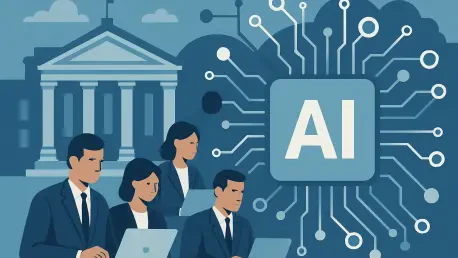As governments across the globe grapple with the complexities of delivering efficient, transparent, and citizen-centric services, artificial intelligence has emerged as a game-changing tool to address these challenges. With the ability to automate routine tasks, analyze massive datasets, and enhance decision-making, AI is no longer just a futuristic concept but a practical solution driving public sector innovation. From fraud detection to streamlining communication, the technology offers unprecedented opportunities to modernize operations and reduce costs. However, the path to adoption is fraught with hurdles, including data privacy concerns and the need for strict compliance with ethical standards. This article delves into the leading AI platforms shaping government functions, explores key strategies for implementation, and highlights the critical balance between innovation and responsibility that agencies must maintain.
Leading AI Solutions for Public Sector Needs
Secure and Scalable Platforms for Government Operations
In the realm of government technology, selecting an AI platform that meets stringent security and scalability requirements is paramount. Gemini for Government, hosted on Google Cloud, stands out with its fortified cloud environment tailored for public sector use. It excels in document summarization and multilingual analysis, making it ideal for agencies handling diverse datasets. Similarly, Microsoft Azure Government AI brings high-level certifications to the table, ensuring compliance for mission-critical and classified workloads. These platforms prioritize robust encryption and access controls, safeguarding sensitive information while offering scalability to meet growing demands. For agencies seeking cost-effective experimentation, the USAi Platform, provided by the U.S. General Services Administration, allows federal entities to explore AI applications like chatbots and automation at no initial cost, fostering innovation within budget constraints.
Custom and Accessible Tools for Diverse Agencies
Beyond proprietary solutions, custom open-source AI frameworks built with tools like TensorFlow or PyTorch offer unparalleled control for agencies with technical expertise. These frameworks enable full customization and data sovereignty, addressing concerns over vendor lock-in and privacy. Meanwhile, ChatGPT Gov, a specialized version from OpenAI, focuses on enhancing internal communication and citizen response systems through generative AI capabilities. This platform is particularly valuable for agencies aiming to improve public engagement without compromising security. The diversity of these tools reflects a broader trend: government AI adoption is not a uniform process but one that requires tailoring to specific mission goals. Whether opting for secure commercial platforms or building bespoke solutions, the emphasis remains on aligning technology with transparency, fairness, and accountability to ensure public trust is never undermined.
Strategies for Effective AI Adoption in Government
Building Trust Through Transparent Governance
Implementing AI in government settings demands a strategic approach that prioritizes transparency and public trust. One effective method is to begin with non-sensitive internal applications, such as analytics or document classification, which minimize risks while allowing agencies to build familiarity with the technology. Transparent governance models are essential, ensuring that AI decision-making processes are explainable and audit trails are clear. This openness helps mitigate fears of algorithmic bias and fosters confidence among citizens. Additionally, compliance with legal and ethical guidelines must be embedded into every stage of deployment, from design to operation. By focusing on these principles, governments can demonstrate a commitment to fairness and accountability, paving the way for broader acceptance of AI tools in public administration over the coming years.
Balancing Security and Collaboration in Hybrid Systems
A critical aspect of AI adoption lies in balancing security with the need for collaboration, often achieved through hybrid environments. Combining on-premises systems for sensitive data with cloud-based solutions for less critical tasks offers a practical compromise. This approach ensures that classified information remains protected while still leveraging the scalability and flexibility of cloud technology for tasks like inter-agency communication. Equally important is the training of staff on responsible AI use, coupled with continuous monitoring to detect and address potential issues in real-time. Such measures are vital for maintaining system integrity and preventing misuse. As governments navigate these complexities, vendor support and cost-effectiveness also play significant roles, especially given the lengthy procurement cycles typical in public sector settings. A well-rounded strategy that addresses these multifaceted needs can significantly enhance the success of AI initiatives.
Reflecting on AI’s Impact and Future Pathways
Lessons Learned from Early AI Integration
Looking back, the journey of integrating AI into government operations revealed both remarkable potential and significant challenges. Platforms like Gemini for Government and Microsoft Azure Government AI proved instrumental in automating workflows and enhancing data analysis, often exceeding expectations for efficiency gains. However, early adopters also encountered hurdles, particularly around ensuring data privacy and preventing bias in automated decisions. The emphasis on transparency and staff training emerged as non-negotiable elements, with many agencies realizing that without these, public trust could easily erode. These experiences underscored the importance of aligning technology with ethical standards, a lesson that shaped subsequent deployments and policy frameworks across various jurisdictions.
Charting the Next Steps for Responsible Innovation
Moving forward, governments must focus on refining AI strategies to prioritize cybersecurity and ethical oversight as core pillars of digital transformation. Investing in continuous education for public sector employees will be crucial to keep pace with evolving technologies. Additionally, fostering partnerships with technology providers can ensure access to cutting-edge tools while maintaining rigorous security standards. Exploring hybrid models further offers a pathway to balance innovation with caution, protecting sensitive data while embracing collaborative opportunities. As agencies build on past insights, the goal should be to create AI systems that not only enhance operational efficiency but also strengthen democratic values by making institutions more responsive and equitable in serving citizens. This balanced approach will define the future of public sector technology.









